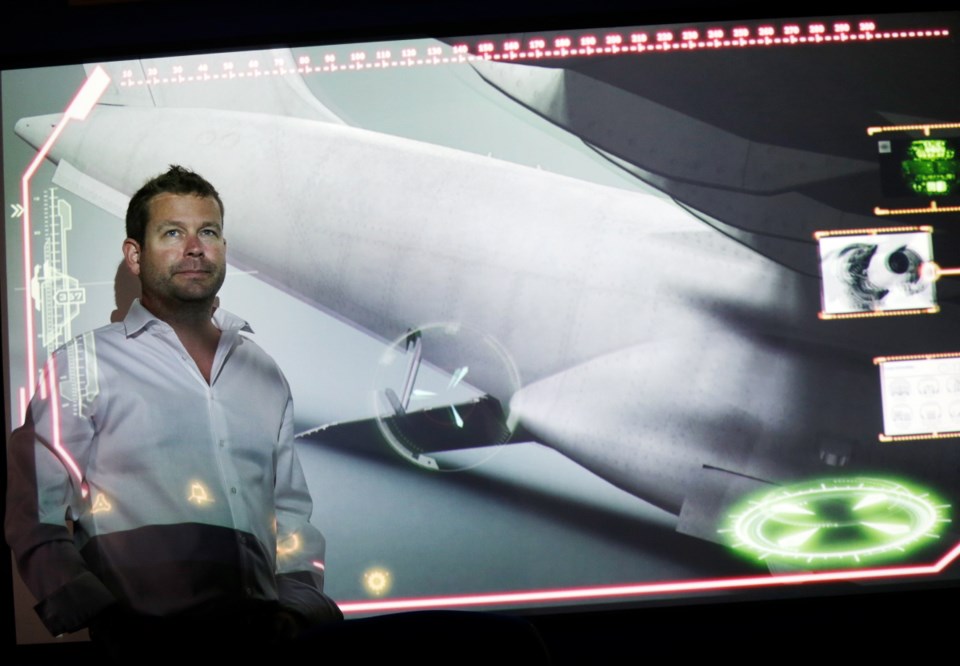RaceRocks 3D Inc. made quite an impression earlier this year when it put together a tongue-in-cheek video message for astronaut Chris Hadfield during his stint in the International Space Station.
But that appears to be just be the tip of the iceberg for the Langford-based technology firm.
“It was a bit of a breakout year, but we have a lot more growing to do,” CEO Scott Dewis said.
The company was formed three years ago to harness 10 years of doing visual effects for Hollywood and the gaming industry and is now improving simulation and training in the defence and aerospace industries. It is poised to double, even triple in size.
Dewis said his team of 20 could increase to 60 by next year and revenues will increase exponentially as they start work on the first of a number of defence industry deals.
“We are on the edge of some major contracts,” Dewis said, noting their commitment in the first year to a $1.7-billion defence contract is worth about $7 million. “We will be doing multiples of our revenues just like that.”
The nature of much of the work and the clients are confidential. There are secure rooms in the offices designed with that in mind, so details on exactly what they will be doing are sparse.
But Dewis said it includes real-world simulations, “game-ified” learning and training applications.
“It’s a means to engage and train without putting people in a classroom and showing them slides or PowerPoints,” he said. “It’s a new way of training people and defence was an early adopter, though the civilian market is catching up.”
The simulations RaceRocks has already put together include flight and marine simulators, a light-rail transit training simulator and a visual demonstration for a provider of unmanned target vehicles who would prefer to show Defence Department buyers how they can use the targets rather than hand them a paper describing the scenario.
Dewis watched animation of an unmanned helicopter get blown from the sky by a missile launched from a submarine. It comes with foreboding music.
It may look like a very realistic video game, but Dewis notes it’s much more than that as it is a fairly simple and self-explanatory visual means of conveying very complex ideas.
The company’s graphic artists have also used their talents and technology to put together computer-based learning modules that show the effects of earthquakes and tsunamis and other disasters for the University of Victoria’s Pacific Institute of Climate Studies and Ocean Networks Canada.
The company has also done promotional videos for the Victoria Royals and for the Victoria Advanced Technology Centre, which asked for help with the Hadfield video.
Dewis said that kind of work is about getting some local exposure, and a break for his creative team.
“That’s fun for the guys. ... We will do stuff under cost or for free simply because it’s something to do for community,” he said.
VIATeC executive director Dan Gunn said RaceRocks has made a great impression locally, given it’s a “cutting edge company doing something no one else is and likes to participate in the community at a very high level.”
Gunn said the company’s success in a relatively short time is partly due to its pedigree. “But it’s also a group of experienced people with really good business sense,” he said. “They haven’t just stuck to what they have always done. They have found new ways to use their talent.”
At this point, the company has evenly split its workload between the defence industry and other endeavours, but that will change significantly.
Dewis said the even split will look more like 90-10 in favour of defence and aerospace very soon.
But he won’t turn his back on other avenues.
“We know defence will be our bread and butter, but it will also allow us to explore other applications of the same technology in other verticals while having a stable company with stable cash flow,” he said.
Now the company is preparing to deal with significant expansion that could start in as little as two weeks. Dewis has brought in technology industry veteran Richard Zwicky to help work on the company’s structure to ensure a smooth transition.



